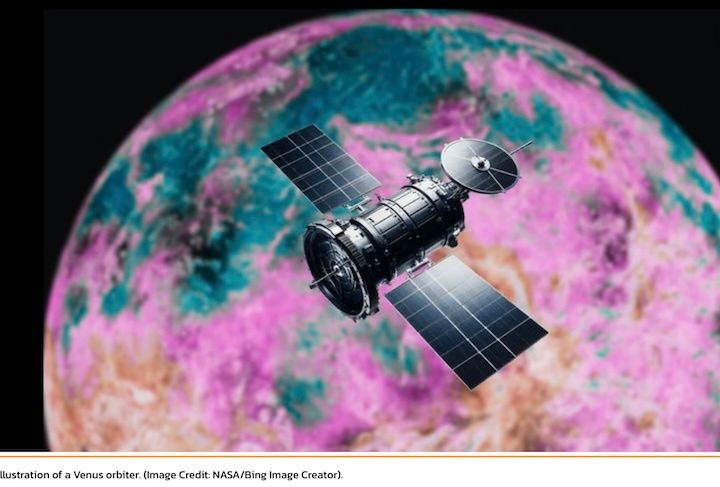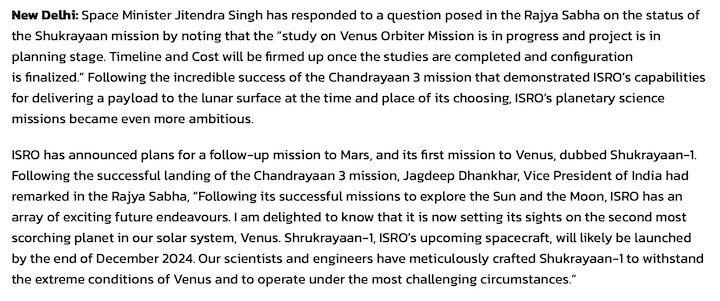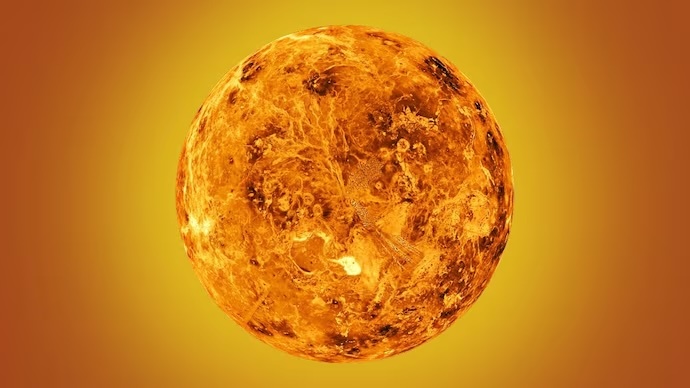13.08.2024




Isro announces launch date of ambitious Venus Orbiter Mission
The venus orbiter Mission aims to study Venus's atmosphere, surface, and geological features using a suite of sophisticated scientific instruments.

The Indian Space Research Organisation (ISRO) is gearing up for its mission to Venus, with the Venus Orbiter Mission (VOM).
The Indian space agency has announced that the spacecraft will take a total of 112 days to travel to Earth's mysterious twin.
The spacecraft is scheduled to launch on March 29, 2028. Shukrayaan-1, will mark India's first foray into exploring the inner planet.
The mission will utilise ISRO's powerful LVM-3 (Launch Vehicle Mark 3) rocket to propel the spacecraft on its 112-day journey to Venus. The orbiter is expected to reach its destination on July 19, 2028, showcasing India's growing capabilities in interplanetary exploration.
VOM aims to study Venus's atmosphere, surface, and geological features using a suite of sophisticated scientific instruments. The mission's primary objectives include investigating the planet's atmospheric composition, surface characteristics, and potential volcanic or seismic activity.
The spacecraft will carry an array of cutting-edge instruments, including synthetic aperture radar, infrared and ultraviolet cameras, and sensors to study Venus's ionosphere. These tools will help scientists unravel the mysteries of Venus's thick, carbon dioxide-rich atmosphere and explore the possibility of active volcanoes on the planet's surface.
India's Venus Orbiter Mission will be equipped with a suite of scientific instruments designed to explore Venus's atmosphere, surface, and plasma environment.
VSAR (Venus S-Band Synthetic Aperture Radar): It aims to search for active volcanism and map Venus with high resolution, providing insights into the planet's topography and surface properties.
VSEAM (Venus Surface Emissivity and Atmospheric Mapper): This hyperspectral spectrometer will study Venus's surface and atmosphere, focusing on volcanic hotspots, cloud structure, and water vapor mapping.
VTC (Venus Thermal Camera): Designed to map thermal emissions from Venusian clouds, it will provide critical data on atmospheric dynamics and planetary-scale features.
VCMC (Venus Cloud Monitoring Camera): This UV and visible wavelength camera will capture atmospheric circulation dynamics and study wave phenomena and lightning.
LIVE (Lightning Instrument for Venus): LIVE will detect electrical activity in Venus’s atmosphere, analyzing lightning and plasma emissions.
VASP (Venus Atmospheric Spectropolarimeter): This instrument will investigate cloud properties and global circulation.
SPAV (Solar Occultation Photometry): SPAV will measure the vertical distribution of aerosols and haze in Venus’s mesosphere.
The Venus Orbiter Mission represents a collaborative effort, with international participation from countries like Russia, France, Sweden, and Germany.
The Swedish Institute of Space Physics (IRF) will contribute the Venusian Neutrals Analyzer (VNA) instrument to study the interaction between charged particles from the Sun and Venus's atmosphere.
With a budget of ₹1,236 crore (approximately $150 million) approved by the Indian government, the Venus Orbiter Mission demonstrates India's commitment to advancing its space exploration capabilities5.
ISRO GETS GOVERNMENT APPROVAL FOR VENUS MISSION “SHUKRAYAAN”
The Indian Space Research Organisation (ISRO) has received approval from the Indian government for its upcoming Venus Orbiting Satellite mission, named Shukrayaan, which is slated for launch in 2028. This announcement was made by Nilesh Desai, Director of ISRO, during a recent media interaction.
“The Indian government has recently given a nod to our Venus Orbiting Satellite — Shukrayaan… It will be launched in 2028… The idea of Chandrayaan 4 has been proposed as a follow up of Chandrayaan 3, where we will land not only on the moon but also will return with soil and rock samples,” Desai said.
Additionally, Desai unveiled plans for Chandrayaan 4, a follow-up to the successful Chandrayaan 3 mission. This ambitious project will be a joint effort between India and Japan, aiming for a precise landing at the Moon’s south pole at 90 degrees south latitude. This mission will also include a significantly heavier rover, weighing 350 kg—12 times the size of its predecessor. Although the project has not yet received full approval, Desai is optimistic that with governmental clearance, the mission could be executed by 2030.
Apart from these missions, ISRO is also working on enhancing its weather and communication systems. Discussions are underway regarding the launch of advanced sensors and satellites as part of the INSAT 4 series. These new technologies will enable ISRO to catch up with global advancements in meteorology and oceanography, improving weather forecasts and satellite communication systems.
Desai also shared plans for future Mars exploration. As part of the Mars mission, ISRO intends not only to place a satellite in Mars’ orbit but also to make an attempt to land on its surface.
“As a part of the Mars mission, we will not only put a satellite on the Mars orbit but we will also attempt to land on it’s suface.. Gaganyaan will be launched in the next two years.. It will be an unmanned flight after which we will launch a manned flight. The government has also given an approval to construct India’s own space station. It will not be as big as the ISS but will have five modules. We will launch the first module in 2028 and India’s space station will be ready by 2035.. As a part of the Prime Minister Narendra Modi’s call to land on the moon by 2040, our space station will function as a transit facility en route,” he said. (ANI)
Quelle: DD News

